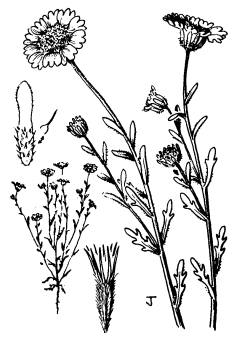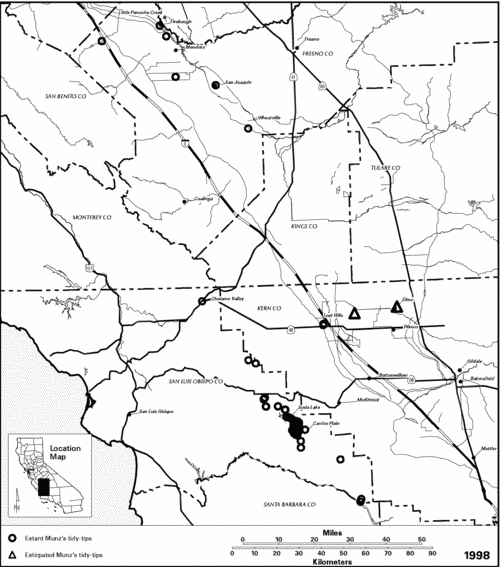Endangered Species Recovery Program | |
|
Home | News | Publications | Species profiles | Data and maps | About | Staff | Links | Department of Biological Sciences | CSU Stanislaus |
Recovery Plan for Upland Species of the San Joaquin Valley, California
Contents
. Introduction
. Species accounts
. Recovery
. Stepdown
. Implementation
. References
. Appendix
9. Munzs Tidy-tips (Layia munzii)
- Taxonomy
- Description
- Historical Distribution
- Current Distribution
- Life History and Habitat
- Reasons for Decline
- Threats to Survival
- Conservation Efforts
- Conservation Strategy
Taxonomy.-- Keck (1935) named Munzs tidy-tips (Layia munzii) in the same publication in which he described Comanche Point layia. The type locality for Munzs tidy-tips is "32 miles (51 kilometers) east of Paso Robles" in San Luis Obispo County (Keck 1935, p. 17). The scientific name has not changed (Baldwin and Bainbridge 1993).
Description.-- Munzs tidy-tips (Figure 28) is closely related to Comanche Point layia but the two species differ in appearance. The stems of Munzs tidy-tips may trail along the ground or grow upright, the leaves are not fleshy, and the ray florets are yellow with white tips. Munzs tidy-tips closely resembles the common tidy-tips (L. platyglossa) and the rare Jones tidy-tips (L. jonesii). These three species are distinguished by subtle characteristics of the flower heads and achenes. Also, Jones tidy-tips has purple streaks on the stem, unlike Munzs tidy-tips (Munz and Keck 1959, Abrams and Ferris 1960, Hoover 1970, Baldwin and Bainbridge 1993).

Figure 28. Illustration of Munz's tidy tips.
Historical Distribution.-- Historically, Munzs tidy- tips was widespread in the western San Joaquin Valley and inner Coast Ranges from Fresno south (Figure 29). In Fresno County, the species was collected near Firebaugh, Little Panoche Creek, Mendota, the town of San Joaquin, and Wheatville. In San Luis Obispo County, Munzs tidy-tips occurred from the Cholame Valley (where the type specimen was collected) to the Carrizo Plain (Hoover 1937, 1970, Twisselmann 1956, CDFG 1995). The species was described as occasional in Kern County (Twisselmann 1967), but the only specific locations reported were west of Wasco and near Elmo (CDFG 1995). According to Abrams and Ferris (1960), Munzs tidy-tips also occurred in Merced County.
Current Distribution.-- Extensive colonies of Munzs tidy-tips remain on the Carrizo Plain, ranging from the area southeast of Soda Lake to California Valley (Lewis 1997). This species also was observed in the vicinity of Lost Hills (Kern County) during the late 1980s. The Wasco and Elmo occurrences have been eliminated; other historical populations have not been revisited in 30 or more years (CDFG 1995).

Figure 29. Distribution of Munz's tidy-tips (Layia munzii).
Life History and Habitat.-- Munzs tidy-tips is an annual that flowers during March and April. Cross-pollination is required for seed set (Munz and Keck 1959). Other facets of the life history have not been studied. Munzs tidy-tips grows on alkaline clay in low-lying areas and on hillsides in grasslands, Valley Saltbush Scrub, and Valley Sink Scrub. Associated species may include red brome, annual fescue, Lost Hills saltbush, common tidy-tips, iodine bush, and spiny saltbush (Hoover 1937, Munz and Keck 1959, Twisselmann 1967, Hoover 1970, Skinner and Pavlik 1994, CDFG 1995, Lewis 1997). On the Carrizo Plain, Munzs tidy-tips is confined to the spiny saltbush zone of the Soda Lake basin. It barely overlaps in range with common tidy-tips, which grows in slightly higher areas (Lewis 1997). Historical and current sites ranged from 45 to 800 meters (150 to 2,600 feet) in elevation (CDFG 1995, Lewis 1997).
Reasons for Decline.-- Both Kern County occurrences of Munzs tidy-tips were destroyed by conversion to agriculture. Many low-lying areas in Fresno, Kern, and San Luis Obispo Counties have been cultivated, which may have destroyed other populations.
Threats to Survival.-- The recently-observed site near Lost Hills is on an airport runway and therefore is subject to continued disturbance. If other Valley-floor sites remain extant, they could be threatened by agricultural conversion and commercial development. A small portion of the Carrizo Plain metapopulation is subject to cattle grazing, but no detrimental effects have been observed to date (Lewis 1997).
Conservation Efforts.-- Russ Lewis of USBLM conducted surveys for Munzs tidy-tips on the Carrizo Plain Natural Area (Lewis 197). The public land portion of the Carrizo Plain metapopulation is in a designated Area of Critical Environmental Concern; USBLM plans to manage the area for the perpetuation of rare species, including Munzs tidy-tips (USBLM 1996ab, Lewis 1997). This species also may occur in reserves on the San Joaquin Valley floor, such as the Center for Natural Lands Managements Semitropic Ridge, or USBLMs Kettleman Hills Area of Critical Environmental Concern, but its presence remains to be verified.
Conservation Strategy.-- To ensure long-term conservation of Munzs tidy-tips, the strategy is to protect at least five populations representing the full historic range of the species. Protected areas should be natural land in blocks of at least 65 hectares (160 acres) and should contain a minimum of 1,000 individuals to reduce the likelihood of extinction from intrinsic or random processes. The presence of this species on public lands does not negate the need for protection elsewhere. Protection from development and incompatible uses is equally important on both public and private lands. Surveys are necessary to determine the current status of historical populations as well as threats facing each occurrence (Skinner and Pavlik 1994). Extant populations should be protected from any site-specific threats and monitored regularly. Munzs tidy-tips could benefit from survey and protection efforts for listed species, including palmate-bracted birds-beak, Fresno kangaroo rat, and Tipton kangaroo rat, and for species of concern such as Lost Hills saltbush and Jareds peppergrass. When surveys have been completed, or at a maximum within 10 years of recovery plan approval, the status of Munzs tidy-tips should be reevaluated.